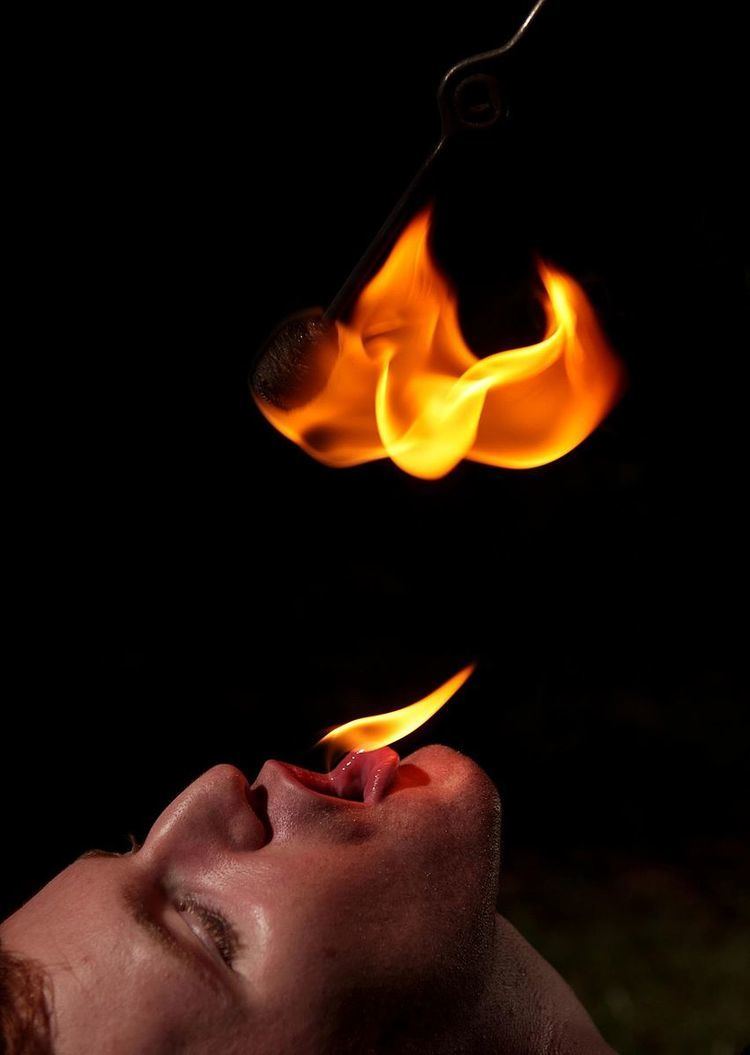 | ||
Fire eating is the act of putting a flaming object into the mouth and extinguishing it. A fire eater can be an entertainer, a street performer, part of a sideshow or a circus act but has also been part of spiritual tradition in India.
Contents
Physics
Fire eating relies on the quick extinction of the fire in the mouth or on the touched surfaces and on the short term cooling effects of water evaporation at the surface on the source of fire (usually with a low percentage of alcohol mixed in the water) or saliva in the mouth. This allows for igniting a damp handkerchief or a bill of money without it burning. Closing the mouth, or covering it with a slap of the hand cuts off the oxygen to the fire. Blowing on it can remove the very thin area of reaction from the source of fuel, and thus extinguish the fire in some cases, where the blown air is faster than the fire front and the flame is small enough to be entirely removed.
The flame itself is not a cold flame, and the performers do not use any other material besides the fuel. Certain materials are avoided when doing the trick, such as materials which may easily ignite, melt or store the heat and release it later. These include paraffin candles, plastic, and thick multithreaded rope.
History, and hazards
Fire eating was a common part of Hindu, Sadhu, and Fakir performances to show spiritual attainment. It became a part of the standard sideshow acts in the late 1880s and was often seen as one of the entry-level skills for sideshow performers, although skilled fire performers, such as those who can utilize the difficult and dangerous vapor transfers and produce large breaths of fire are regarded as equals in the circus community for their skill and devotion to their art.
Other than sound fire safety precautions and some practical advice regarding the laws of physics (i.e. "hot air rises"), there are few secrets to eating fire. Torches do not burn with "cold flames" nor is there any special substance in the performer's mouth other than saliva. It is instead the cutting off of the oxygen from the flame which extinguishes it and the evaporation of saliva with the water in the alcoholic solution which keeps the nearby surfaces cool while it is still burning. Even so, according to Daniel Mannix's 1951 sideshow memoir Step right up!, the real "secret" to fire eating is enduring pain; he mentions that tolerating constant blisters on your tongue, lips and throat is also necessary. Many other fire eaters dismiss this, claiming that a skilled fire eater should not burn themselves. The most common method of safely performing fire eating acts relies on the fact that it takes time to transfer heat, and that heat rises in air. Fire eating and fire breathing (and all variants) is a skill which should be passed on from a skilled master to an appropriate student and almost all teachings include instructions on first aid, fire safety, chemistry and other appropriate skills. Accidental ingestion of fuel or improper technique can lead to a serious condition known as fire eater's pneumonia.
Famous fire eaters
A famous fire eater from the 18th century was Robert Powell who allegedly not only swallowed fire but also red-hot coals, melted sealing wax and even brimstone. He performed, often in front of British and other European royalty and nobility, for nearly sixty years and in 1751 was awarded a purse of gold and a large silver medal.
Although not the earliest, the first to attract the attention of the upper classes was an Englishman named Richardson, who first performed in France in 1667. His methods were subsequently made public by his servant.
Guinness World Records
The most torches extinguished in one minute with the mouth (using multiple rods) is 99 and was achieved by Bret Pasek (U.S.A.) at the Minnesota Renaissance Festival in Shakopee, Minnesota, on 7 September 2014.
The longest duration fire torch teething is 3 minutes 38.39 seconds and was achieved by Alexander Spitfire(U.S.A) at Circo Draconum's Draco's Inferno in Hell's Kitchen Lounge Newark, New Jersey on August 30, 2015.
Fire-eating tricks
While trick categories (vapor, transfers, extinguishes, etc.) are recognized by most, it is important to note that specific trick names may vary greatly depending on the region of the world in which the student learned.
Vapor tricks
Vapor tricks utilize the fuel vapors held in the mouth during or before an extinguish.
Transfers
Transfers are methods of moving a flame from one area to another, by using the body, or another surface or medium.
Extinguishes
Extinguishes are methods of extinguishing torches, and are the traditional hallmark of fire eating.
